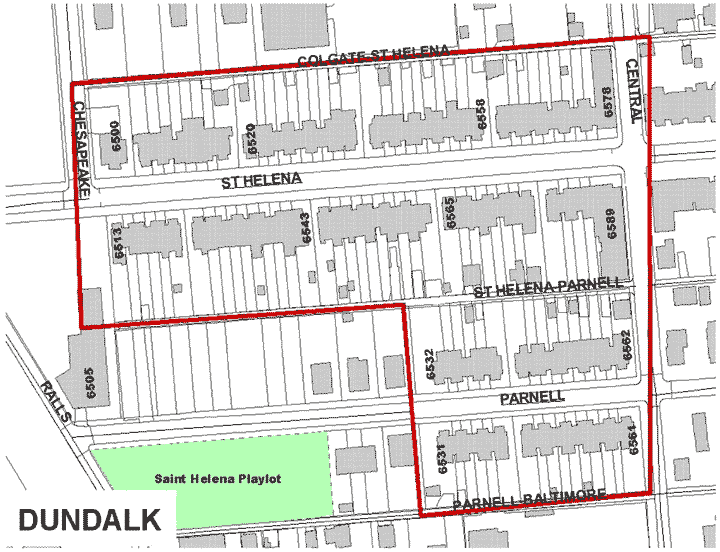Dundalk
National Register of Historic Places 12/8/83
Certified Historic District for Tax Incentives (NR)
(Most of this district lies in Baltimore County, however, over 100 buildings fall within Baltimore City limits.)
Description
 Dundalk, Maryland, is an unincorporated community in Baltimore County located just southeast of Baltimore City. The Dundalk Historic District, while primarily in the county, extends slightly into the city so as to fully encompass the significant resources of this early 20th century community. Although bisected into eastern and western sections (commonly known respectively as Old Dundalk and St. Helena), the district is a cohesive unit made up of residential, commercial, and institutional buildings.
Dundalk, Maryland, is an unincorporated community in Baltimore County located just southeast of Baltimore City. The Dundalk Historic District, while primarily in the county, extends slightly into the city so as to fully encompass the significant resources of this early 20th century community. Although bisected into eastern and western sections (commonly known respectively as Old Dundalk and St. Helena), the district is a cohesive unit made up of residential, commercial, and institutional buildings.
Structures generally date from 1910-1940 and document all phases of the district's growth during that period. Major architectural styles include Period Revival (particularly Colonial Revival and Tudor Revival) and Art Deco/Art Moderne. Much of the district is laid out in a plan which is a good example of "Garden City" planning precepts. The integrity of this plan is excellent, including the retention of a variety of open space areas. Such integrity is also seen in the buildings of the district, which have generally undergone relatively reversible alterations. This integrity of plan and architectural fabric, plus the relative lack of intrusive modern structures, makes the Dundalk Historic District a cohesive and significant source of architectural documentation.
Significance
The Dundalk Historic District is a significant community for its historical associations and for its architecture. Historically, the district is important for encompassing the only two housing developments built by the United States Shipping Board Emergency Fleet Corporation (EFC) in Maryland during World War I. As such, Dundalk is representative of the Federal government's first venture into the field of housing. Essentially intact in terms of building and plan, the community is a particularly good source of documentation for the EFC projects.
Dundalk is also significant as an expression of early twentieth century community planning. The plan of much of the district, with its curvilinear streets and planned community center, reflects experimentation with Garden City planning ideals. Another important influence upon the community's development was the Bethlehem Steel Corporation, which controlled much of the district's physical growth to a greater or lesser degree. Thus, Dundalk is also significant as an example of one type of "company town." With respect to architecture, the district represents a significant and well-preserved collection of examples of early 20th century Period Revival and Art Deco/Art Moderne styles. This general architectural cohesiveness, plus the overall integrity of the district, tends to produce a distinct sense of place. Many of the buildings within the District represent the work of noted Baltimore architect Edward L. Palmer.